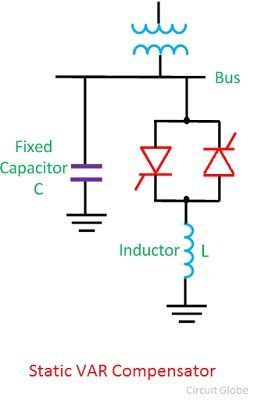A static VAR compensator is a parallel combination of controlled reactor and fixed shunt capacitor shown in the figure below. The thyristor switch assembly in the SVC controls the reactor. The firing angle of the thyristor controls the voltage across the inductor and thus the current flowing through the inductor. In this way, the reactive power draw by the inductor can be controlled.
 The SVC is capable of step less adjustment of reactive power over an unlimited range without any time delay. It improves the system stability and system power factor. Most commonly used SVC scheme are as follows.
The SVC is capable of step less adjustment of reactive power over an unlimited range without any time delay. It improves the system stability and system power factor. Most commonly used SVC scheme are as follows.
- Thyristor controlled reactor (TCR)
- Thyristor-switched capacitor (TSC)
- Self Reactor (SR)
- Thyristor controlled reactor – Fixed capacitor (TCR-FC)
- Thyristor-switched capacitor – Thyristor controlled reactor (TSC-TCR)
Advantage of Static VAR Compensator
- It increased the power transmission capability of the transmission lines.
- It improved the transient stability of the system.
- It controlled the steady state and temporary overvoltages.
- It improved the load power factor, and therefore, reduced line losses and improved system capability.
Static VAR compensator has no rotating parts and is employed for surge impedance compensation and compensation by sectionalizing a long transmission line.

Thanks.
Simple and effective. Add details about the different svc system also.Thanks for the content.
Is there any disadvantages of SVC in any aspect?
Is there any disadvantage of using SVC in any aspect?